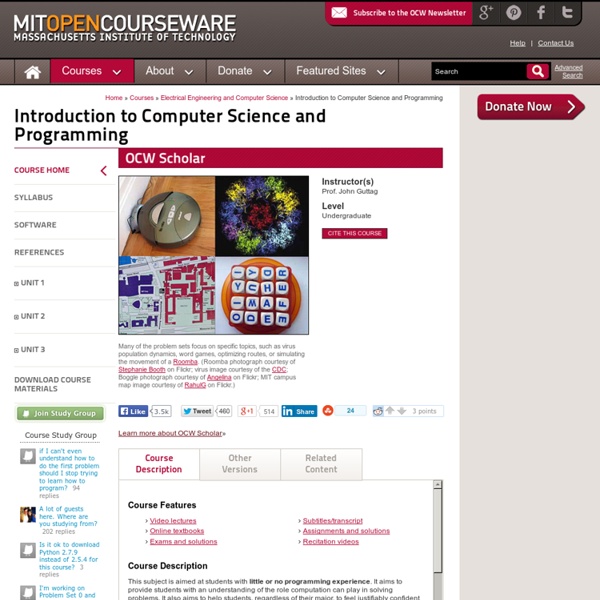The history of computer data storage, in pictures
Nowadays we are used to having hundreds of gigabytes of storage capacity in our computers. Even tiny MP3 players and other handheld devices usually have several gigabytes of storage. This was pure science fiction only a few decades ago. For example, the first hard disk drive to have gigabyte capacity was as big as a refrigerator, and that was in 1980. Not so long ago! Pingdom stores a lot of monitoring data every single day, and considering how much we take today’s storage capacity for granted, it’s interesting to look back and get things in perspective.
S189: Introduction to Python - Materials
This mini quiz is totally and entirely optional. You don't need to turn it in, it is all for your benefit. You are, however, more than welcome to go over your solutions with the teaching staff, or get help if you are having trouble with any of the problems. However, do try to give this an honest shot, as it'll help you get a feel for your programming skills. Handouts
Developing Digital Design Techniques (doctoral thesis)
Doctoral Thesis 2005 Download full thesis here >>>>> Abstract Industrial designers, architects, graphical designers and others have slowly adapted to the new digital design tools. Most of this process of adaptation is about modifying traditional techniques to benefit from digital technology. But digital technology offers the possibility to rethink the design process even to a degree where our conception of visual creativity is questioned.
CSI Knowledge: How Bloodstain Pattern Analysis Works (Infographic) : Discovery Channel
You know how it goes: Right before Horatio Caine puts on his sunglasses and throws off a corny one-liner as the The Who screams, the forensics team is looking at a blood splatter on the wall and determining that it was a gunshot wound from close range by a six-foot tall, left handed shooter who wore sandals and had a limp. READ MORE: Whisky, Buried in Antarctic Ice for 100 Years, is Finally Ready for You to Drink Far fetched? Maybe not. You’d be surprised at the amount of detail a simple blood spatter can reveal.
Style Guide for Python Code
Code should be written in a way that does not disadvantage other implementations of Python (PyPy, Jython, IronPython, Cython, Psyco, and such).For example, do not rely on CPython's efficient implementation of in-place string concatenation for statements in the form a += b or a = a + b. This optimization is fragile even in CPython (it only works for some types) and isn't present at all in implementations that don't use refcounting. In performance sensitive parts of the library, the ''.join() form should be used instead. This will ensure that concatenation occurs in linear time across various implementations.Comparisons to singletons like None should always be done with is or is not, never the equality operators.Also, beware of writing if x when you really mean if x is not None -- e.g. when testing whether a variable or argument that defaults to None was set to some other value. The other value might have a type (such as a container) that could be false in a boolean context!
KS3 Computing - Wikibooks, open books for an open world
Germ of this book[edit] This book started with a Hack the curriculum event on Saturday 18th April 2015, where volunteers met to start creating this book. It will need lots more help and work before it's ready for general use. Please see the Editing Guide to help and to contribute. Additional information is available at Introduction to this book[edit]
An Intro to Interactive Programming in Python - Coursera/Rice
About this course: This two-part course is designed to help students with very little or no computing background learn the basics of building simple interactive applications. Our language of choice, Python, is an easy-to learn, high-level computer language that is used in many of the computational courses offered on Coursera. To make learning Python easy, we have developed a new browser-based programming environment that makes developing interactive applications in Python simple. These applications will involve windows whose contents are graphical and respond to buttons, the keyboard and the mouse. In part 1 of this course, we will introduce the basic elements of programming (such as expressions, conditionals, and functions) and then use these elements to create simple interactive applications such as a digital stopwatch. Part 1 of this class will culminate in building a version of the classic arcade game "Pong".
The Nature of Code
Hello! By browsing the table of contents on your left, you can read the entire text of this book online for free, licensed under a Creative Commons Attribution-NonCommercial 3.0 Unported License. Start reading the introduction now!
Glossary
The default Python prompt of the interactive shell. Often seen for code examples which can be executed interactively in the interpreter. The default Python prompt of the interactive shell when entering code for an indented code block or within a pair of matching left and right delimiters (parentheses, square brackets or curly braces). 2to3


